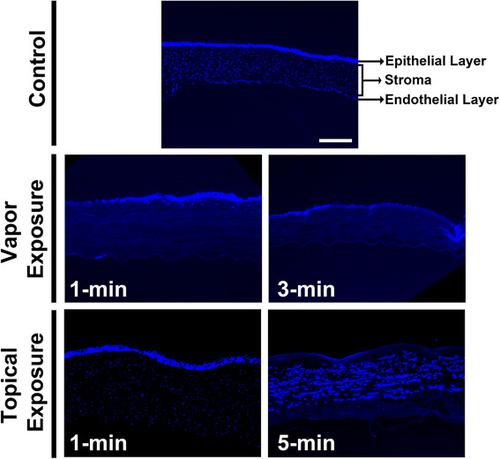当前位置:
X-MOL 学术
›
Ann. N. Y. Acad. Sci.
›
论文详情
Our official English website, www.x-mol.net, welcomes your
feedback! (Note: you will need to create a separate account there.)
A rabbit model for evaluating ocular damage from acrolein toxicity in vivo
Annals of the New York Academy of Sciences ( IF 4.1 ) Pub Date : 2020-10-16 , DOI: 10.1111/nyas.14514 Suneel Gupta 1, 2 , Michael K Fink 1, 2 , Lynn M Martin 1, 2 , Prashant R Sinha 1, 2 , Jason T Rodier 1, 3 , Nishant R Sinha 1, 2 , Nathan P Hesemann 1, 3 , Shyam S Chaurasia 1, 2 , Rajiv R Mohan 1, 2, 3
Annals of the New York Academy of Sciences ( IF 4.1 ) Pub Date : 2020-10-16 , DOI: 10.1111/nyas.14514 Suneel Gupta 1, 2 , Michael K Fink 1, 2 , Lynn M Martin 1, 2 , Prashant R Sinha 1, 2 , Jason T Rodier 1, 3 , Nishant R Sinha 1, 2 , Nathan P Hesemann 1, 3 , Shyam S Chaurasia 1, 2 , Rajiv R Mohan 1, 2, 3
Affiliation

|
Acrolein is a highly reactive and volatile unsaturated aldehyde commonly used for producing scores of commercial products. It has been recognized as a chemical weapon since its use during World War I, and more recently, in Syria. Acrolein exposure causes severe eye, skin, and lung damage in addition to many casualties. In the eye, it causes severe pain, eyelid swelling, corneal burns, and vision impairment. Very little information is available about how acrolein damages the cornea and causes vision loss. At present, the lack of clinically relevant animal models limits evaluation of acrolein toxicity and mechanisms specific to the eye. We aim to standardize the mode of delivery and exposure duration of acrolein, damaging the rabbit eye in vivo as an ocular injury model for studying the toxicity of acrolein and developing medical countermeasures. Rabbit eyes were exposed to two modes of delivery (topical and vapor) for different durations (1–5 minutes). Clinical ophthalmic examinations with a slit lamp, stereomicroscope, fluorescein dye, pachymeter, tonometer, and tearing examinations in live rabbits were performed at various times up to 4 weeks. Corneas were histologically diagnosed for transparency, fibrosis, collagens, and neovascularization. Our study successfully established an in vivo rabbit model for evaluating acrolein toxicity to the eye, accounting for different modes and durations of exposure.
中文翻译:

评估体内丙烯醛毒性眼部损伤的兔模型
丙烯醛是一种高反应性和挥发性不饱和醛,通常用于生产多种商业产品。自从第一次世界大战期间以及最近在叙利亚使用以来,它就被认为是化学武器。除了造成许多人员伤亡外,接触丙烯醛还会造成严重的眼睛、皮肤和肺部损伤。在眼睛中,它会导致剧烈疼痛、眼睑肿胀、角膜烧伤和视力障碍。关于丙烯醛如何损害角膜并导致视力丧失的信息很少。目前,缺乏临床相关的动物模型限制了丙烯醛毒性和眼睛特异性机制的评估。我们的目标是标准化丙烯醛的递送方式和暴露时间,体内损伤兔眼作为眼损伤模型,用于研究丙烯醛的毒性和制定医疗对策。兔眼暴露于两种给药方式(局部给药和蒸汽给药)不同的持续时间(1-5 分钟)。使用裂隙灯、立体显微镜、荧光素染料、测厚计、眼压计进行临床眼科检查,并在长达 4 周的不同时间对活兔进行撕裂检查。通过组织学诊断角膜的透明度、纤维化、胶原蛋白和新血管形成。我们的研究成功建立了体内兔模型,用于评估丙烯醛对眼睛的毒性,并考虑了不同的暴露模式和持续时间。
更新日期:2020-10-16
中文翻译:

评估体内丙烯醛毒性眼部损伤的兔模型
丙烯醛是一种高反应性和挥发性不饱和醛,通常用于生产多种商业产品。自从第一次世界大战期间以及最近在叙利亚使用以来,它就被认为是化学武器。除了造成许多人员伤亡外,接触丙烯醛还会造成严重的眼睛、皮肤和肺部损伤。在眼睛中,它会导致剧烈疼痛、眼睑肿胀、角膜烧伤和视力障碍。关于丙烯醛如何损害角膜并导致视力丧失的信息很少。目前,缺乏临床相关的动物模型限制了丙烯醛毒性和眼睛特异性机制的评估。我们的目标是标准化丙烯醛的递送方式和暴露时间,体内损伤兔眼作为眼损伤模型,用于研究丙烯醛的毒性和制定医疗对策。兔眼暴露于两种给药方式(局部给药和蒸汽给药)不同的持续时间(1-5 分钟)。使用裂隙灯、立体显微镜、荧光素染料、测厚计、眼压计进行临床眼科检查,并在长达 4 周的不同时间对活兔进行撕裂检查。通过组织学诊断角膜的透明度、纤维化、胶原蛋白和新血管形成。我们的研究成功建立了体内兔模型,用于评估丙烯醛对眼睛的毒性,并考虑了不同的暴露模式和持续时间。











































 京公网安备 11010802027423号
京公网安备 11010802027423号